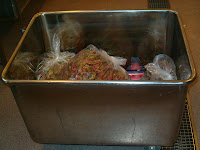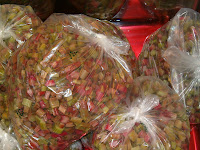"Thanksgiving Day on the Farm"
Thursday, Nov. 26, 2009
This year we had a beautiful Thanksgiving Day. The weather was still mild, the iron planters in our yard are breathtaking with the winter heather in them, we had gone into the forest several days before and brought back our Advent tree for the farm for this season, and we had the two missionaries coming from Örnsköldsvik to spend the day with us. Here is a rundown of the activities and fun we had....
The tree: Each year the boys and Hans keep their eyes open for the "best" tree for Advent. It must have a good shape, be large but not so big that we can't get to the top to put the lights on, be strong and healthy so it will last through the blustery winter days, etc. It always stands in the center of the quad on the farm and should be up and lit by the fourth Sunday before Christmas which is Advent.
On that morning Manny and Gustav went out to search at Östensjö where we found the tree last year. Soon they were home to say they had found a good one so Nainy and Kezia went with them (Manny drove the tractor and Nainy, Kezia and Gustav followed in the car) to see it. When we got there we decided to look a little farther than the one they had seen first and we found one that was even better, just excellent!
By the time we got back to the farm and hoisted it into the hole where it was to stand, we were losing the light. That was all we could do for that day.
On Thanksgiving Day, getting it up, shimmed straight, stabilized, and the lights started were the top priorities. We were so glad to have Elder Harris (St. George, Utah - only a few months left on his mission) and Elder Blaylock (Virginia - just arrived in Sweden) with us to help. It was chilly and damp, but they braved it with wonderful spirits. The challenge was how to get up high enough so that the top could be lighted. The scoop on the tractor wouldn't reach. The four of them talked it over and here is the result...that's Manny in the picture on the left on the large ladder which they wedged through the space between the tractor body and the front bucket scoop so that he could reach high enough to start putting the lights on the very top. Such a bunch of smarties! On the right is Gustav with Elder Harris (left) and Elder Blaylock (right).
Not only did they work on the tree, but once that was rolling they split into two teams and Harris and Gustav also worked on capping the wood bags for the winter.
Then, while Kezia and I finished up the dinner the Elders went into Junsele to visit their investigators. By the time they got back it was time to eat.
Hooray!
The Food: We had gone into the ICA grocery store in the village about two weeks ago to order turkeys (one for Thanksgiving and one for the day after Christmas). Turkey is not common in Sweden so we thought we would get a jump on it. To our surprise, Tomas, the butcher at ICA, had already anticipated our need and had two in for us! So kind. They weighed in at 10.5 pounds each. We wondered how it would be, it seemed so small compared to what we were used to in the past, but it was the perfect size when stuffed.
 We wanted to have the traditional dinner, but to take it a step farther, we also wanted to do the turkey in the woodstove for the first time. Kezia had brought pumpkin, evaporated milk, fresh cranberries and other goodies in her suitcase. By a stroke of incredible luck, when she got to the Stockholm airport, for some reason they didn't bother to check her through customs.
We wanted to have the traditional dinner, but to take it a step farther, we also wanted to do the turkey in the woodstove for the first time. Kezia had brought pumpkin, evaporated milk, fresh cranberries and other goodies in her suitcase. By a stroke of incredible luck, when she got to the Stockholm airport, for some reason they didn't bother to check her through customs.
Eureka!

 We had turkey, gravy, stuffing, creamed onions & peas (from our garden), corn, mashed potatoes (also from our garden), fresh cranberry/orange relish, red currant saft (from our bushes) and all the extras. For dessert we had Mrs. Flounders' pumpkin pie and a beautiful apple crisp that Kezia made, both with whipped cream. So delicious. The biggest bonus of all was the turkey from the woodstove. It was the most delicious and moist of any turkey we had ever eaten. It was great to learn how to do it and have it turn out so successfully.
We had turkey, gravy, stuffing, creamed onions & peas (from our garden), corn, mashed potatoes (also from our garden), fresh cranberry/orange relish, red currant saft (from our bushes) and all the extras. For dessert we had Mrs. Flounders' pumpkin pie and a beautiful apple crisp that Kezia made, both with whipped cream. So delicious. The biggest bonus of all was the turkey from the woodstove. It was the most delicious and moist of any turkey we had ever eaten. It was great to learn how to do it and have it turn out so successfully.
At each meal on the farm we always start by singing a hymn, praying and reading a chapter from the scriptures (this year it is Book of Mormon in the morning, New Testament in the evening). Elder Harris had served in Örnsköldsvik before and had been to the farm and eaten with us about a year ago, so he was familiar with the mealtime devotional. It was so wonderful to hear him say quietly as we prepared to start, "I love this part", referring to the hymn/prayer/scripture reading tradition. We love it too, and especially the wonderful spirit of peace it invites into our home each time.
We sang, "Come, Ye Thankful People, Come", prayed, and read. Towards the end of the meal we went around the table and each one told something he or she was thankful for. The only thing that could have made it more perfect was if Papa Hans would have been with us. We missed him so much and felt grateful for his goodness as a husband, father and provider as the head of our home. We are so blessed to have him!
Our hearts are filled with gratitude for a beautiful & memorable Thanksgiving Day! We hope you had the same.






































